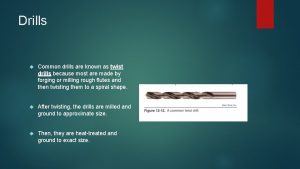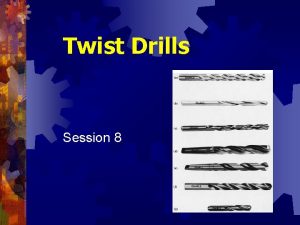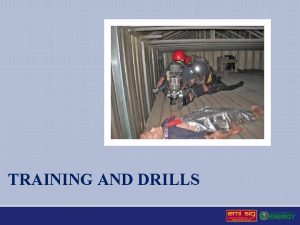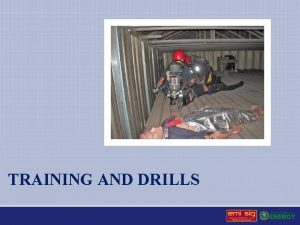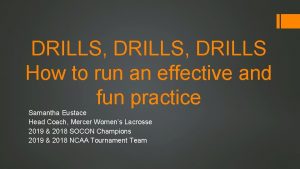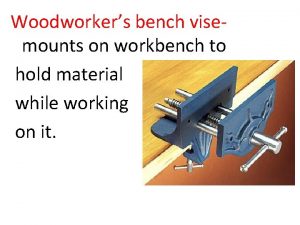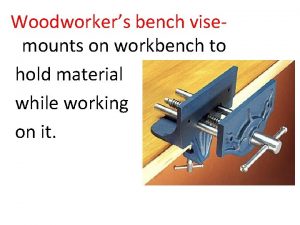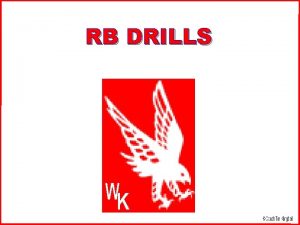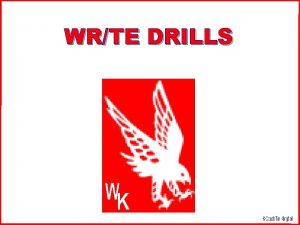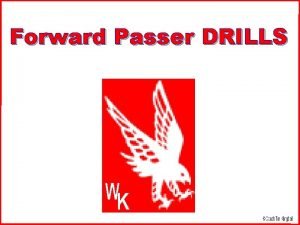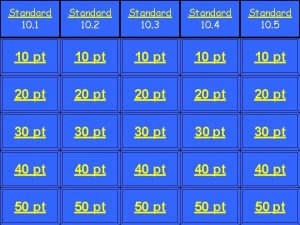Twist Drills for Woodworkers Standard twist drills and





































- Slides: 37

Twist Drills for Woodworkers Standard twist drills and two methods of sharpening 10 January 2015 Marc Pohm

Twist Drills for Woodworking • Topics that will be covered: – Coatings – Steel Types – Drill Points – Drill length – Flutes – Shank Types – Sharpening

Coatings Drills are available in many finishes. Some of these finishes are bright, black oxide, Ti. N, Zr. N, Al. Ti. N, Ti. Br, and Ti. CN. Black oxide which retains coolant and Ti. N, Zr. N, Al. Ti. N, Ti. Br, and Ti. CN coatings which increase lubricity and prevent edge buildup and cratering are all metal working issues. For woodworking the best finish is BRIGHT with a POLISHED flute. If you are going to use the same drills for casual metal working and woodworking, would recommend Black Oxide finish.

Steel Types • • Carbon Stainless High Speed Steel (HSS or HS) Cobalt Tungsten Carbide Tipped Solid Carbide

Carbon Steel Carbon steels are the softest and least expensive tool steels. Almost all woodworking hand tools are made from carbon steel. Tools are heat treated to 45 c – 62 c hardness. Those between 45 c – 55 c can be sharpened with a file. Those between 55 c – 62 c require some type of sharpening stone. If overheated during sharpening, hardness will be lost. Lowest tempering temperature is 350°F. Common identifiers are W 1, O 1, A 2, D 2, S 2, and 115 Cr. V 3. Drills made from carbon steel should only be used at low speeds. If drill is too hot to touch, reduce the speed.

Stainless Steel Stainless steel drills stay sharp twice as long, have greater toughness, and are less likely to break. Usually hardened to 45 c and can be sharpened with a file. Have same tolerance to heat as carbon steel, but must be kept cool.

High Speed Steel (HSS) In wood and plastic all grades of HSS far outlast carbon and stainless steel. Not nearly as sensitive to heat, turning blue is not death of tool. Common identifiers are M 1, M 2, M 7 and M 50. M 2 is most common grade in drills. Tool should always be marked with HSS or HS. Lowest tempering temperature is 1000°F. Beware of an ad copy that does not identify which alloy it is. I have been burned twice by major woodworking tool retailers. This is the recommended steel for woodworking drills.

Cobalt Steel Cobalt steel is a step up from high speed steel offering better tool life and greater hardness. Drills made of cobalt steel have a heavier web for drilling hardened steel, which results in a shallower flute. Lowest tempering temperature is 950°F. They do not work well in wood or plastic because they do not clear chips well.

Tungsten Steel You may find these at a yard sale; they were used before cobalt steels were developed. For example, were used at aircraft plant that was located near airport. Common identifiers are T 1, T 2, T 3, T 5, T 6 and T 15. Avoid these drills. Very difficult to sharpen, tougher then grinding wheel. Don’t try to use a diamond wheel; they will cause the diamonds to burn. Remember, diamonds are after all carbon.

Carbide Tipped Carbide is super hard, impervious to heat, and extremely brittle. Because of brittleness, carbide tipped drills should only be used in a drill press or rigid machine setup. Carbide in woodworking tools is different from carbide in metalworking tools. Contact with metal while cutting wood will generally damage cutting edge. Drilling thousands of holes in hardwoods that contain high levels of silica is possible with carbide tipped drills. Woods such as teak, black locust, cocobolo, ipe, etc. Sharpening requires a diamond grinding wheel.

Solid Carbide tools are very expensive and are usually manufactured and used for special applications. High speed spindle and rigid machine setup required. These types of tools are best sharpened by the original manufacturer; the grinding dust in many cases is toxic.

Drill Points • • Regular or Standard Point Split Point Multi-facet Point Plexi Point Screw Point Taper Point Brad Point

Regular or Standard Point The 118° point is designed to be an all-purpose point and will cut most materials, but is seldom the best drill point. Has a 118° included angle point with cutting relief angles suited to cut metal. The most common drill point sold and used. Not the best point for woodworking. The drill point that we will be sharpening with today.

Regular or Standard Point

Split Point drills usually have 135° included angle points and are designed to cut metal. The Split Point drill has two additional edges ground into the chisel edge, which removes the blunt angle and makes it a cutting edge. This reduces the amount of pressure needed to make the drill cut. The Split Point is also self centering which means the drill starts cutting exactly where is comes into contact with the material. These characteristics were designed for drilling in metal but could be beneficial in some harder woods. The “Drill Doctor” will also grind this point.

Split Point

Multi-facet Point Multi-faceted geometry generates less heat than any other drill point pattern. With equal diameters, the multi-faceted drill features 50% less thrust and 60% less heat than a conventional drill. Four-faceted drill points consist of separate cutting lip (primary) and secondary heel clearance (relief) facets. Extending the secondary facets to the midway point of the chisel produces the apex (point) at the center of the chisel's long axis. Primary facet angles are determined by the nature of the drilled material while the secondary facet angles are at 20°. The six-faceted drill with secondary point angles (SPA) is the most durable of points, but least understood and utilized. The fifth and sixth facets forming secondary drill point angles.

Multi-facet Point four facet

Multi-facet Point six facet

Plexi Point drills are designed to cut Plexiglas. The point can be between 60° and 80° included angle and the cutting angles are reduced to keep the drill from biting into the Plexiglas too fast. This point produces a clean hole and prevents the drill from breaking the Plexiglas when drilling through the backside.

Screw Points are found strictly on wood cutting tools. These types of points are sometimes called Self Feeding points. Screw Points are designed to assist and control the rate of feed for that tool. In other words, the screw point controls how fast the tool cuts, and all but eliminates the need to push the tool. It is a must when drilling large holes with hand held equipment. The disadvantage of tools with screw points is, unless the screw point is replaceable, the tool will only last until the screw wears out. That may not take long in hardwoods.

Screw Point Damaged drills are often found at house construction sites after electrician or plumber found a nail while drilling a hole. Generally free for the asking. Convert screw to brad point and sharpen cutting flute with a file. Good once again for construction work.

Taper Point Drills are designed specifically to pre-drill for the shank and threads of standard wood screws. Available in sizes and lengths to cover a wide variety of screws. Some customers have had success using this type of drill to cut through holes when a clean edge is required breaking through the backside. The Taper Point Drill breaks through gradually and produces clean edges on both sides.

Brad Point A Brad Point Drill should provide the cleanest, straightest, and most accurately sized hole in wood. The brad in the center of the point allows accurate positioning when starting a hole even if the hole is not 90 degrees from the surface. The outlining spurs shear the wood grain and leave a clean edge around the opening of the hole eliminating the need for sanding. The spurs continue to shear the wood while drilling and produce an accurately sized hole. In most woods, the spurs also help to produce a cleaner edge when drilling through the backside of the wood. Brad Point Drills are available in every size including Fractional, Wire Gauge, Letter Sizes, Metric Sizes and longer or shorter lengths.

Brad Point • For Softwoods For Hardwoods

Drill length Length of drill is based on its diameter. Lengths available for ¼” (. 250) drills. Center drill Spotting drill Screw Machine Jobber drill Taper length drill Aircraft Length Extra long ¼” flute ¾” flute 1 - 3/8” flute 2 - ¾” flute 3 - ¾” flute 2 – ¾” flute 11” flute 2” length 2 - ½” length 4” length 6 - 1/8” length 6” or 12” length 15” length The best drill length to use is the shortest drill that will do the job. The short drill will be stiffer and produce a more accurate hole in both size and location.

Flutes The flute form of a drill is extremely critical to its performance. The shape of the flute determines the ability of the drill to form, accommodate, and escalate the chips, thus carrying away heat. The flutes of conventional drills are typically formed with a shaped grinding wheel which addresses the axis of the drill blank in such a manner as to provide a straight cutting lip, an appropriate land width and a predefined gullet area. Parabolics are quite a bit more expensive than the average jobber length twist drills, but for deep holes, they are well worth it.

Flutes

Shank Types Round Hexagon Partial Hexagon Taper SDS Spline Reduced shank Other shanks

Round Shank • The most common shank used today. • It is only suitable for use with drills under ½”.

Hexagon Shank Partial Hexagon Shank • Both offer slip free grip of drill in chuck. • Hexagon Partial Hexagon

Taper Shank Best general purpose shank for drills over ½”. Drill point and shank are highly concentric. Drills available up to 4. 000” in diameter as stock item. Tang at end of shank prevents slippage. Shank has Morse Taper ranging from 1 MT to 5 MT.

SDS and Spline Shank • Both are used almost exclusively with hammer and impact drills. • SDS Spline

Reduced Shank Also know as “Silver & Deming Drills”. A marketing solution to use a too small of chuck for a drill that is too big. Damaged shank is a common condition when used. If you must use it, use slow speed and gentle feed.

Other shanks There are many other proprietary shanks for special purposes. Many allow for the flow of coolant through drill with outlet just behind cutting edge.

Sharpening Demo

Sharpening OK, previously shown Jig will not work. The drill sharpeners we will demo today work with drills as small as 1/8”. Both sharpeners work better with larger drills. Neither is suitable for a production environment. Demonstration of “General” drill sharpener. Demonstration of “Drill Doctor” sharpener.
 Woodworkers tool nyt crossword
Woodworkers tool nyt crossword Woodworkers groove crossword
Woodworkers groove crossword Standard error statistics
Standard error statistics What language you speak at home
What language you speak at home Standard costs are
Standard costs are Kontinuitetshantering
Kontinuitetshantering Typiska drag för en novell
Typiska drag för en novell Tack för att ni lyssnade bild
Tack för att ni lyssnade bild Returpilarna
Returpilarna Shingelfrisyren
Shingelfrisyren En lathund för arbete med kontinuitetshantering
En lathund för arbete med kontinuitetshantering Adressändring ideell förening
Adressändring ideell förening Tidbok
Tidbok A gastrica
A gastrica Densitet vatten
Densitet vatten Datorkunskap för nybörjare
Datorkunskap för nybörjare Stig kerman
Stig kerman Debatt artikel mall
Debatt artikel mall Delegerande ledarstil
Delegerande ledarstil Nyckelkompetenser för livslångt lärande
Nyckelkompetenser för livslångt lärande Påbyggnader för flakfordon
Påbyggnader för flakfordon Lufttryck formel
Lufttryck formel Svenskt ramverk för digital samverkan
Svenskt ramverk för digital samverkan Lyckans minut erik lindorm analys
Lyckans minut erik lindorm analys Presentera för publik crossboss
Presentera för publik crossboss Vad är ett minoritetsspråk
Vad är ett minoritetsspråk Plats för toran ark
Plats för toran ark Treserva lathund
Treserva lathund Luftstrupen för medicinare
Luftstrupen för medicinare Claes martinsson
Claes martinsson Centrum för kunskap och säkerhet
Centrum för kunskap och säkerhet Byggprocessen steg för steg
Byggprocessen steg för steg Mat för unga idrottare
Mat för unga idrottare Verktyg för automatisering av utbetalningar
Verktyg för automatisering av utbetalningar Rutin för avvikelsehantering
Rutin för avvikelsehantering Smärtskolan kunskap för livet
Smärtskolan kunskap för livet Ministerstyre för och nackdelar
Ministerstyre för och nackdelar Tack för att ni har lyssnat
Tack för att ni har lyssnat






































